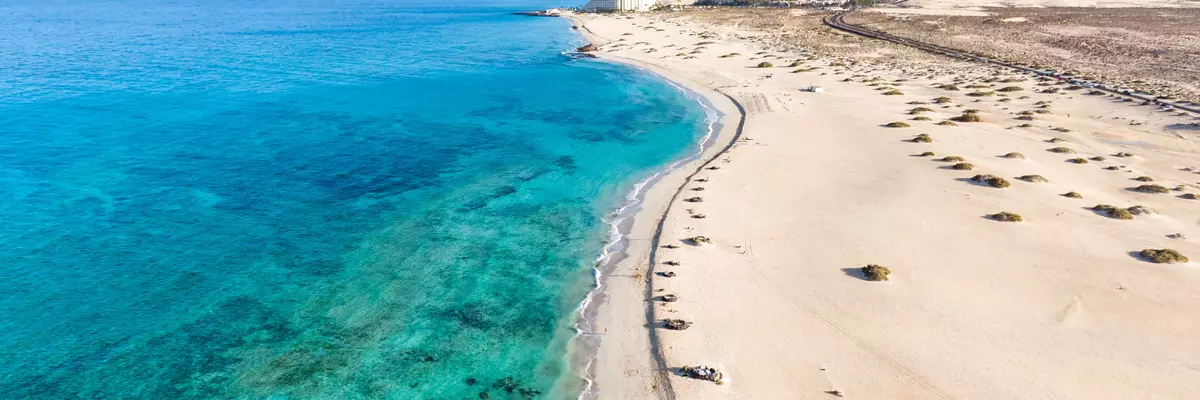Climate Table Fuerteventura
Jan | Feb | Mar | Apr | May | Jun | Jul | Aug | Sep | Oct | Nov | Dec | |
|---|---|---|---|---|---|---|---|---|---|---|---|---|
| Max. Temperature | 19° | 19° | 20° | 21° | 23° | 24° | 27° | 27° | 26° | 24° | 21° | 19° |
| Min. Temperature | 12° | 12° | 13° | 13° | 15° | 16° | 18° | 19° | 18° | 17° | 15° | 13° |
| Sun Hours | 6 | 7 | 8 | 8 | 9 | 9 | 10 | 10 | 8 | 7 | 6 | 6 |
| Water Temperature | 18° | 18° | 17° | 17° | 18° | 20° | 20° | 21° | 22° | 22° | 20° | 19° |
| Rain Days | 3 | 2 | 1 | 1 | 1 | 0 | 0 | 0 | 0 | 1 | 3 | 3 |
The climate year of Fuerteventura
Fuerteventura, the Canary Island is a popular vacation destination for tourists. It has the reputation of being the most barren of the Canaries, especially in the east and in its south it consists of pure desert. The vegetation in the west and north of the island is not more floral, but in these parts of Fuerteventura the volcanoes and the interesting landscape clearly dominate. Thus, these were also significantly involved in the formation of Fuerteventura. On the west coast of the island, the vacationer will find lava rocks in black, combined with white rock formations and a boisterous surf, the sight of which together seem wild and romantic. The landscape of Fuerteventura was formed with the island piece by piece by volcanic activities and looks back on a history of origin of 20.6 million years, whereby the main part of the island is supposed to have been formed about 5 million years ago. However, due to constant erosion, rock has been quarried again and again over the last million years, thus shaping the island. Since about 5000 years there were no more volcanic activities on Fuerteventura, so there were no more changes. With its size of 1660 square kilometers Fuerteventura represents next to Tenerife the second largest Canary Island and is located 120 km west of the coast of Morocco. Geographically, the island in the Atlantic Ocean is already Africa assigned, while administratively it is under the region of Las Palmas.
General information about Fuerteventura
On Fuerteventura the vacationer finds a variety of deserts, beaches and high dunes. Thus, the island offers the bathing holidaymaker perfect conditions, dreamlike views and wild landscapes, lonely bays can be found in the east of the coasts (especially in Jandia or at Costa Calma) in a few minutes and delight the holidaymaker's heart. Kitesurfers, windsurfers, surfers and other water sports enthusiasts will find steady winds in the north, which has always made the vacation destination interesting for this group of vacationers. In Fuerteventura's west, one should definitely stay away from the cliffs with their life-threatening currents. Exciting is a visit to the caves of Ajuy, which are made of limestone and older than the island itself. Armed with flashlights, the caves are visited via a walkway that can be flooded at any time by the surf. The botanical garden in La Lajita with the Oasis Park also offers the adventurous a zoo with animal shows and baby animals or a variety of parrot species to touch as well as a great camel safari. Also worth a visit is the Montana Tindaya, this highest and as a holy mountain named offers fantastic views and an exciting past.
Tourism Fuerteventura
Of all the Canary Islands, Fuerteventura is recorded as the driest of the islands, with a remarkably mild climate throughout the year. The excessive heat is generally compensated by the coolness of the sea and the hot desert masses coming from the Sahara are largely stopped by the trade winds acting here. Climatically, Fuerteventura can be classified as a so-called semi-desert with a tendency to a direct desert climate, which with an average of 148 mm is considered to have very little precipitation. The temperatures remain almost constantly warm throughout the year, although the climate diagram shows an average increase of a few degrees in the summer months from June to September. During Calima, a very hot wind from the east with Sahara quality, the temperature can rise completely suddenly by almost 10 degrees.


